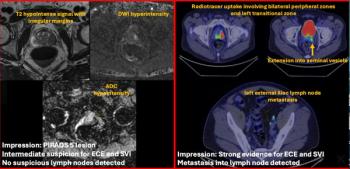
New Chest Imaging Study Finds Intrathoracic Complications in 20 Percent of Patients with COVID-19
The retrospective study, which involved nearly 1,000 patients with COVID-19, found that a high initial chest radiograph severity score was an independent risk factor for intrathoracic complications.
Newly published research suggests one in five patients with COVID-19 may develop intrathoracic complications that more than double the length of hospital stay in comparison to those without complications and carry a significantly elevated risk for intensive care unit (ICU) admission.
The study, which was recently published in
Researchers also noted that a high severity score on chest radiograph was independently associated with the development of intrathoracic complications, leading to a greater than 11-fold risk of ICU admission and over a 50 percent reduction in successful extubation.
In light of the correlation between chest imaging findings and intrathoracic complications, the study authors emphasize radiologists having a seat at the interdisciplinary table when it comes to the workup and management of patients with COVID-19.
“The association between imaging findings and outcomes highlights the vital role of the radiologist and supports the need for radiologists to be actively involved with interdisciplinary care teams to provide imaging interpretation and insights into the implication of complications,” wrote Quynh A. Truong, MD, MPH, a professor of radiology at Weill Cornell Medicine, and colleagues.
In addition to aiding treating physicians in predicting which patients may need a higher level of care based on the imaging findings, Truong and colleagues said the information from chest imaging may help alleviate anxiety for patients and their family members, and/or possibly initiate discussions about optimal care moving forward.
“For example, pneumothorax, chest tube placement, pneumomediastinum, and pleural effusions were predictors of failure to extubate while other complications such as pneumomediastinum and lobar collapse were not,” pointed out Truong and colleagues. “It may provide comfort that certain otherwise disconcerting findings do not necessarily correlate with mortality, although they may predict significant morbidity (e.g. tracheostomy).”
The study authors conceded limitations of the study. They acknowledged that research was performed at the early stages of the COVID-19 pandemic in New York City and that the results may not be applicable to current patients hospitalized for COVID due to advances in treatment and management, or patients in community or rural health care facilities. Truong and colleagues also noted no recording of the timing of complications relative to each other and other events.
Newsletter
Stay at the forefront of radiology with the Diagnostic Imaging newsletter, delivering the latest news, clinical insights, and imaging advancements for today’s radiologists.




























